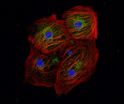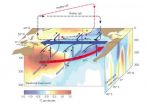(Press-News.org) TEMPE, Ariz. – Life in a warming world is going to require human ingenuity to adapt to the new realities of Earth. Greenhouse-gas induced warming and megapolitan expansion are both significant drivers of our warming planet. Researchers are now assessing adaptation technologies that could help us acclimate to these changing realities.
But how well these adaptation technologies – such as cool roofs, green roofs and hybrids of the two – perform year round and how this performance varies with place remains uncertain.
Now a team of researchers, led by Matei Georgescu, an Arizona State University assistant professor in the School of Geographical Sciences and Urban Planning and a senior sustainability scientist in the Global Institute of Sustainability, have begun exploring the relative effectiveness of some of the most common adaptation technologies aimed at reducing warming from urban expansion.
The work showed that end-of-century urban expansion within the U.S. alone and separate from greenhouse-gas induced climate change, can raise near surface temperatures by up to 3 C (nearly 6 F) for some megapolitan areas. Results of the new study indicate the performance of urban adaptation technologies can counteract this increase in temperature, but also varies seasonally and is geographically dependent.
In the paper, "Urban adaptation can roll back warming of emerging megapolitan regions," published in the online Early Edition of the Proceedings of the National Academy of Sciences, Georgescu and Philip Morefield, Britta Bierwagen and Christopher Weaver all of the U.S. Environmental Protection Agency, examined how these technologies fare across different geographies and climates of the U.S.
"This is the first time all of these approaches have been examined across various climates and geographies," said Georgescu. "We looked at each adaptation strategy and their impacts across all seasons, and we quantified consequences that extend to hydrology (rainfall), climate and energy. We found geography matters," he added.
Specifically, what works in California's Central Valley, like cool roofs, does not necessarily provide the same benefits to other regions of the U.S., like Florida, Georgescu said. Assessing consequences that extend beyond near surface temperatures, like rainfall and energy demand, reveals important tradeoffs that are oftentimes unaccounted for.
Cool roofs are a good example. In an effort to reflect incoming solar radiation, and therefore cools buildings and lessen energy demand during summer, painting one's roof white has been proposed as an effective strategy. Cool roofs have been found to be particularly effective for certain areas during summertime.
However, during winter these same urban adaptation strategies when deployed in northerly locations, further cool the environment and consequently require additional heating to maintain comfort levels. This is an important seasonal contrast between cool roofs (i.e. highly reflective) and green roofs (i.e. highly transpiring). While green roofs do not cool the environment as much during summer, they also do not compromise summertime energy savings with additional energy demand during winter.
"The energy savings gained during the summer season, for some regions, is nearly entirely lost during the winter season," Georgescu said.
In Florida, and to a lesser extent Southwestern states of the U.S., there is a very different effect caused by cool roofs.
"In Florida, our simulations indicate a significant reduction in precipitation. The deployment of cool roofs results in a 2 to 4 millimeter per day reduction in rainfall, a considerable amount (nearly 50 percent) that will have implications for water availability, reduced stream flow and negative consequences for ecosystems," he said. "For Florida, cool roofs may not be the optimal way to battle the urban heat island because of these unintended consequences."
Georgescu said the researchers did not intend to rate urban adaptation technologies as much as to shed light on each technology's advantages and disadvantages.
"We simply wanted to get all of the technologies on a level playing field and draw out the issues associated with each one, across place and across time."
Overall, the researchers suggest that judicious planning and design choices should be considered in trying to counteract rising temperatures caused by urban sprawl and greenhouse gasses. They add that, "urban-induced climate change depends on specific geographic factors that must be assessed when choosing optimal approaches, as opposed to one size fits all solutions."
INFORMATION:
Source:
Matei Georgescu, (480) 727-5986
Media contact:
Skip Derra, (480) 965-4823; skip.derra@asu.edu
Research reveals the give and take of urban temperature mitigating technologies
2014-02-10
ELSE PRESS RELEASES FROM THIS DATE:
The genetic origins of high-altitude adaptations in Tibetans
2014-02-10
Genetic adaptations for life at high elevations found in residents of the Tibetan plateau likely originated around 30,000 years ago in peoples related to contemporary Sherpa. These genes were passed on to more recent migrants from lower elevations via population mixing, and then amplified by natural selection in the modern Tibetan gene pool, according to a new study by scientists from the University of Chicago and Case Western Reserve University, published in Nature Communications on Feb. 10.
The transfer of beneficial mutations between human populations and selective ...
Study involving twin sisters provides clues for battling aggressive cancers
2014-02-10
CINCINNATI – Analyzing the genomes of twin 3-year-old sisters – one healthy and one with aggressive leukemia – led an international team of researchers to identify a novel molecular target that could become a way to treat recurring and deadly malignancies.
Scientists in China and the United States report their findings online Feb. 9 in Nature Genetics. The study points to a molecular pathway involving a gene called SETD2, which can mutate in blood cells during a critical step as DNA is being transcribed and replicated.
The findings stem from the uniquely rare opportunity ...
Genome editing goes hi-fi
2014-02-10
SAN FRANCISCO, CA—February 9, 2014—Sometimes biology is cruel. Sometimes simply a one-letter change in the human genetic code is the difference between health and a deadly disease. But even though doctors and scientists have long studied disorders caused by these tiny changes, replicating them to study in human stem cells has proven challenging. But now, scientists at the Gladstone Institutes have found a way to efficiently edit the human genome one letter at a time—not only boosting researchers' ability to model human disease, but also paving the way for therapies that ...
Cochlear implants -- with no exterior hardware
2014-02-10
Cochlear implants — medical devices that electrically stimulate the auditory nerve — have granted at least limited hearing to hundreds of thousands of people worldwide who otherwise would be totally deaf. Existing versions of the device, however, require that a disk-shaped transmitter about an inch in diameter be affixed to the skull, with a wire snaking down to a joint microphone and power source that looks like an oversized hearing aid around the patient's ear.
Researchers at MIT's Microsystems Technology Laboratory (MTL), together with physicians from Harvard Medical ...
Scientists invent advanced approach to identify new drug candidates from genome sequence
2014-02-10
JUPITER, FL—February 9, 2014—In research that could ultimately lead to many new medicines, scientists from the Florida campus of The Scripps Research Institute (TSRI) have developed a potentially general approach to design drugs from genome sequence. As a proof of principle, they identified a highly potent compound that causes cancer cells to attack themselves and die.
"This is the first time therapeutic small molecules have been rationally designed from only an RNA sequence—something many doubted could be done," said Matthew Disney, PhD, an associate professor at TSRI ...
Fight or flight? Vocal cues help deer decide during mating season
2014-02-10
Previous studies have shown that male fallow deer, known as bucks, can call for a mate more than 3000 times per hour during the rut (peak of the mating season), and their efforts in calling, fighting and mating can leave them sounding hoarse.
In this new study, published today (10 February) in the journal Behavioral Ecology, scientists were able to gauge that fallow bucks listen to the sound quality of rival males' calls and evaluate how exhausted the caller is and whether they should fight or keep their distance.
"Fallow bucks are among the most impressive vocal athletes ...
Pacific trade winds stall global surface warming -- for now
2014-02-10
Heat stored in the western Pacific Ocean caused by an unprecedented strengthening of the equatorial trade winds appears to be largely responsible for the hiatus in surface warming observed over the past 13 years.
New research published today in the journal Nature Climate Change indicates that the dramatic acceleration in winds has invigorated the circulation of the Pacific Ocean, causing more heat to be taken out of the atmosphere and transferred into the subsurface ocean, while bringing cooler waters to the surface.
"Scientists have long suspected that extra ocean ...
Seven new genetic regions linked to type 2 diabetes
2014-02-10
Seven new genetic regions associated with type 2 diabetes have been identified in the largest study to date of the genetic basis of the disease.
DNA data was brought together from more than 48,000 patients and 139,000 healthy controls from four different ethnic groups. The research was conducted by an international consortium of investigators from 20 countries on four continents, co-led by investigators from Oxford University's Wellcome Trust Centre for Human Genetics.
The majority of such 'genome-wide association studies' have been done in populations with European ...
Optogenetic toolkit goes multicolor
2014-02-10
CAMBRIDGE, MA -- Optogenetics is a technique that allows scientists to control neurons' electrical activity with light by engineering them to express light-sensitive proteins. Within the past decade, it has become a very powerful tool for discovering the functions of different types of cells in the brain.
Most of these light-sensitive proteins, known as opsins, respond to light in the blue-green range. Now, a team led by MIT has discovered an opsin that is sensitive to red light, which allows researchers to independently control the activity of two populations of neurons ...
Clues to cancer pathogenesis found in cell-conditioned media
2014-02-10
Philadelphia, PA, February 10, 2014 – Primary effusion lymphoma (PEL) is a rare B-cell neoplasm distinguished by its tendency to spread along the thin serous membranes that line body cavities without infiltrating or destroying nearby tissue. By growing PEL cells in culture and analyzing the secretome (proteins secreted into cell-conditioned media), investigators have identified proteins that may explain PEL pathogenesis, its peculiar cell adhesion, and migration patterns. They also recognized related oncogenic pathways, thereby providing rationales for more individualized ...






